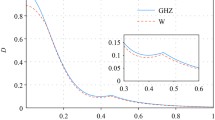Abstract
First a Stern-Gerlach type experiment on a beam of electrons similar to Brillouin's 1927 proposal is discussed and shown to be feasible contrary to claims in the literature. Then thecontinuous Stern-Gerlach effect for an individual electron in classical oscillatory motion along the axis of a Penning trap is introduced. The analogy is developed between the classic Stern-Gerlach effect and the continuous one, in which a magnetic bottle replaces the constant field gradient and the place of the glass plate collecting the silver atoms is taken by a meter measuring the frequency of the axial oscillation. Quantum jumps observed with this apparatus in 1977 are exhibited, demonstrating the requirement of a finite time for collapse of the wave function, and the work has been recognized as an early quantum-non-demolitionexperiment. A plot of measuredg-factors vs normalized radius for triton, proton, and electron suggests a new, 104× smaller value for the electron radius, when our electrong-value determined by magnetic resonance and the continuous Stern-Gerlach effect is used. The plot further suggests a progression of ever smaller and heavier fermions until “the” elementary particle, the “cosmon”, is reached. It was formed, when in a random quantum jump the metastable vacuum dissociated into a lone “cosmon/anticosmon” pair, whose subsequent rapid breakup initiated the Big Bang.
Similar content being viewed by others
References
Dehmelt, H.: Adv. At. Mol. Phys.3, 55 (1967);5, 109 (1969)
Dehmelt, H.: Phys. Scr. T22, 102 (1988)
Pauli, W.: Handbuch der Physik V/1. Flügge, S. (Hrsg.), mostly Sects. 9, 12, 23. Berlin, Göttingen, Heidelberg: Springer 1958. I have relied exclusively on the original german text
Van Dyck, Jr., R.S., Schwinberg, P.B., Dehmelt, H.G.: Phys. Rev. D34, 722 (1986)
Dehmelt, H.: Bulletin of magnetic resonance4, No. 1/2, 17 (1982)
Wheeler, A., Zurek, W. (ed.): Quantum theory and measurement, mostly pp. XVII, 699, 781, 784, 786. Princeton: Princeton University Press 1983
Kessler, J.: Polarized electrons, 2nd Edn., p. 5, Chap. 8. Berlin, Heidelberg, New York: Springer 1985
Sivers, D.: Phys. Rev. D2, 2048 (1970)
Pauli, W.: In: Le magnetism, 6ème Conseil de Physique Solvay, Bruxelles 1930, mostly pp. 183–186, 217–220 and 275–280. Paris: Gauthier-Villars 1932
Dehmelt, H., Ekstrom, P.: Bull. Am. Phys. Soc.18, 727 (1983)
Dehmelt, H.: Proc. Natl. Acad. Sci. USA83, 2291, 3074 (1986)
Van Dyck, Jr., R.S., Ekstrom, P., Dehmelt, H.: Nature262, 776 (1976)
Nagourney, W., Sandberg, J., Dehmelt, H.: Phys. Rev. Lett.56, 2797 (1986)
Van Dyck, Jr., R.S., Schwinberg, P.B., Dehmelt, H.G.: In: New frontiers in high energy physics. Kursunoglu, B., Perlmutter, A., Scott, L. (eds.). New York: Plenum 1978
Dehmelt, H.: Atomic masses and fundamental constants. Sanders, J.H., Wapstra, A.H. (eds.), p. 504. New York: Plenum 1976
Dehmelt, H., Ekstrom, P., Wineland, D., Van Dyck, R.: Bull. Am. Phys. Soc.19, 572 (1974)
Van Dyck, Jr., R.S., Schwinberg, P.B., Dehmelt, H.G.: Phys. Rev. Lett.38, 310 (1977)
Van Dyck, Jr., R.S., Schwinberg, P.B., Dehmelt, H.G.: In: Atomic physics 9. Van Dyck, R.S., Fortson, E.N. (eds.), p. 53. New York: World Scientific 1984
Braginsky, V., Vorontsov, Y.: Sov. Phys. Usp.17, 644 (1975)
Caves, C.M.: In: Quantum optics, experimental gravitation, and measurement theory. Meystre, P., Scully, M. (eds.), p. 594. New York: Plenum 1983
Pauli, W.: Naturwissenschaften19, 188 (1931)
Dirac, P.A.M.: The principles of quantum mechanics, Paragraph 69. Oxford: Oxford University Press 1958
Gardner, J.H., Purcell, E.M.: Phys. Rev.83, 996 (1951)
Dehmelt, H.: In: Advances in laser science II. Stwally, W.C., Lapp, M. (eds.), New York: AIP Conference Proceedings 1987
Chambers, E.E., Hofstadter, R.: Phys. Rev.103, 1454 (1956)
Simon, G.G., Schmitt, C., Borkowski, F., Walther, V.W.: Nucl. Phys. A333, 381 (1980)
Huang, K.: Am. J. Phys.20, 479 (1952)
Frisch, R., Stern, O.: Z. Phys.85, 4 (1933)
Rabi, I.I., Kellogg, J.M.B., Zacharias, J.R.: Phys. Rev.46, 157 (1934)
Brodsky, S.J., Drell, S.D.: Phys. Rev. D22, 2236 (1980)
Van Dyck, Jr., R.S., Schwinberg, P.B., Dehmelt, H.G.: Phys. Rev. Letters59, 26 (1987)
Kinoshita, T.: Proceedings of Symposium on the Hydrogen Atom, Pisa 1988




